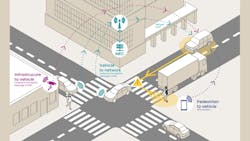R&D Effort Aims at V2X Comms Between Autonomous Vehicles
The French technology research institute CEA-Leti is kicking off a new R&D initiative that hopes to result in a higher level of vehicle automation and cooperation. It will do so by exploiting recent developments in vehicular wireless communications that improve reaction time, pedestrian detection, and overall vehicle performance.
Building on its participation in three EU H2020 projects, CEA-Leti scientists have consolidated the institute’s expertise in vehicle-to-everything (V2X) communication technologies and standards. CEA-Leti’s efforts are aimed at evaluating and demonstrating connected and cooperative vehicular systems to improve automation.
In turn, scientists hope to help ensure the safety of vulnerable road users, such as pedestrians, workers, and cyclists (see figure). Further, the institute aims to help its partners in the automotive and related industries understand and adopt the benefits of V2X cooperative communications.
Those earlier H2020 studies included integrating a dedicated simulation flow for system-level evaluation of different short- and long-range radio technologies, such as IEEE 802.11.p/bd, C-V2X sidelink, or 5G NR. They also investigated different architecture and infrastructure options, including roadside units, 5G base stations, and MEC servers.
Another key H2020 accomplishment was the development of a simulation tool used to measure the actual impact of observed communication network performance in terms of latency, link reliability, coverage, and load on the critical vehicular applications. The measurements yielded insights into service availability and continuity, the allowed level of automation, time to collision, and other critical parameters.
V2X communication technologies and protocols were initially developed to improve road safety through cooperation between vehicles. However, with more autonomous fleets of collaborative robots and drones coming online, similar research questions and challenges have arisen in various complex mobile operating contexts. An approach like that being developed for V2X applications could also find uses for collision avoidance and cooperative maneuvers by autonomous robots in smart factories.
Looking ahead, CEA-Leti is exploring possible extensions of these H2020 studies in application fields for which standardization is still in its infancy, notably in connection with 6G. These may include cooperative robotics and digital twinning in factories of the future.


